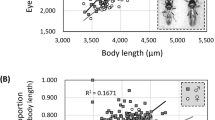Abstract
FLUCTUATING asymmetries are the small random deviations from symmetry that occur in the development of bilaterally symmetrical traits1. Such asymmetries are believed to be a direct indicator of phenotypic, perhaps genotypic, quality2. Relative levels of asymmetry are much greater in secondary sexual characters than in normal morphological traits2. It has been proposed that females use the amount of asymmetry in secondary sexual ornamentation as a cue in mate choice3, because the highest quality individuals have the most symmetrical, as well as elaborate, ornaments2–10. Using a choice chamber similar to that in ref. 11, we show here that female zebra finches choose symmetrically leg-banded males over asymmetrically banded ones. This demonstrates unequivocally that females use symmetry as a criterion in partner preference, although whether the symmetry preference is specific to secondary sexual characters is unknown.
This is a preview of subscription content, access via your institution
Access options
Subscribe to this journal
Receive 51 print issues and online access
$199.00 per year
only $3.90 per issue
Buy this article
- Purchase on Springer Link
- Instant access to full article PDF
Prices may be subject to local taxes which are calculated during checkout
Similar content being viewed by others
References
Ludwig, W. Das Rechts-Links Problem im Tiereich und beim Menschen (Springer, Berlin, 1932).
Møller, A. P. & Pomiankowski, A. Genetica (in the press).
Møller, A. P. Nature 357, 238–240 (1992).
Manning, J. T. & Hartley, M. A. Anim. Behav. 42, 1020–1021 (1991).
Møller, A. P. Anim Behav. 40, 1185–1187 (1990).
Møller, A. P. Proc. R. Soc. B248, 199–206 (1992).
Møller, A. P. & Höglund, J. Proc. R. Soc. B245, 1–5 (1991).
Thornhill, R. Behav. Ecol. 3, 277–283 (1992).
Thornhill, R. Behav. Ecol. Sociobiol. 30, 357–363 (1992).
Thornhill, R. & Sauer, P. Anim. Behav. 43, 255–264 (1992).
Burley, N., Krantzberg, G. & Radman, P. Anim. Behav. 30, 444–455 (1982).
Van Valen, L. Evolution 16, 125–142 (1962).
Bradbury, J. W. & Andersson, M. B. Sexual Selection: Testing the Alternatives (Wiley, Chichester, 1987).
Møller, A. P. Proc. R. Soc. B243, 59–62 (1991).
Burley, N. Auk 102, 647–651 (1985).
Burley, N. Am. Nat. 127, 415–455 (1985).
Burley, N. Anim. Behav. 34, 1732–1741 (1986).
Burley, N. Evolution 40, 1191–1206 (1986).
Burley, N. Ethology 76, 133–151 (1987).
Burley, N. Am. Nat. 132, 611–628 (1988).
Burley, N. Anim. Behav. 36, 1235–1237 (1988).
Burley, N. Science 211, 721–722 (1981).
Ryan, M. J., Fox, J. H., Wilczynski, W. & Rand, A. S. Nature 343, 66–67 (1990).
Basolo, A. L. Science 250, 808–810 (1990).
Enquist, M. & Arak, A. Nature 361, 446–448 (1993).
Russell, E. S. A. N. Y. Acad. Sci. 57, 597–605 (1954).
Beardmore, J. A. Heredity 14, 411–422 (1960).
Endler, J. A. & McLellan, T. A. Rev. Ecol. Syst. 19, 395–421 (1988).
SPSS Inc. SPSSx User'ls Guide 3rd edn (SPSS Inc., Chicago, 1988).
Author information
Authors and Affiliations
Rights and permissions
About this article
Cite this article
Swaddle, J., Cuthill, I. Preference for symmetric males by female zebra finches. Nature 367, 165–166 (1994). https://doi.org/10.1038/367165a0
Received:
Accepted:
Issue Date:
DOI: https://doi.org/10.1038/367165a0
This article is cited by
-
Symmetry and its transition in phyllotaxis
Journal of Plant Research (2021)
-
A tale of two tails: asymmetry in Great Grey Shrike (Lanius excubitor)
Avian Research (2018)
-
Ultraviolet reflectance influences female preference for colourful males in the European serin
Behavioral Ecology and Sociobiology (2014)
-
Symmetry perception in bamboo sharks (Chiloscyllium griseum) and Malawi cichlids (Pseudotropheus sp.)
Animal Cognition (2014)
Comments
By submitting a comment you agree to abide by our Terms and Community Guidelines. If you find something abusive or that does not comply with our terms or guidelines please flag it as inappropriate.



